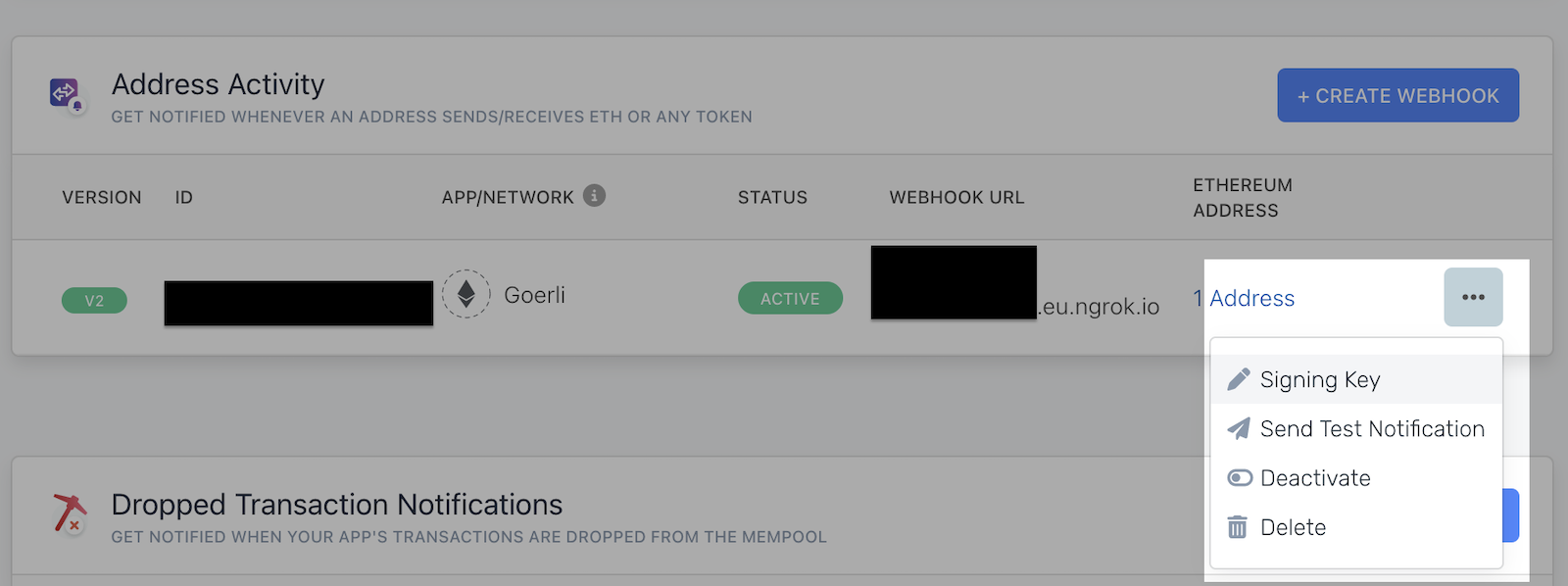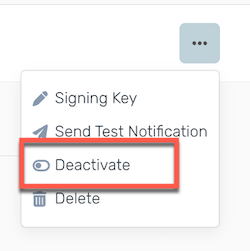Alchemy Notify via Mailchain
At the end of this tutorial, we will have built a simple Express App that exposes an API to listen for ethereum address activity (e.g. ERC20, ERC721 and ERC1155 transfer events).

We will be using the Alchemy Notify API quickstart. It provides easy-to-use webhook triggers based on transactions and events, and supports multiple webhook event types. We will use the Address Activity Webhook to send a mail to your ethereum address when a transaction occurs. The code for the webhook is based on the Authenticated webhook tutorial, which is not a prerequisite, but can be helpful to review.
Prerequisites
To complete this tutorial, you need to first:
- Download and install NodeJS.
- Create a new Mailchain account for development and testing purposes.
- Register an Ethereum address in Mailchain to your dev and test account.
- Sign in or create Alchemy account
- Ngrok account with Ngrok installed on your machine.
Ngrok will be used to expose the localhost to the internet in order to be accessible for the webhook, but feel free to use your own solution (e.g. gitpod.io) to expose the localhost for testing purposes.
Step 1 - Clone Alchemy Notify example
Alchemy has a great 'Getting Started with Notify API' example repository on GitHub. We will clone this repository and use the Node Express example.
To clone the Alchemy webhook examples and navigate into the correct folder, run the following commands in a new terminal:
git clone https://github.com/alchemyplatform/webhook-examples.git
cd webhook-examples/node-express
Now run yarn in this directory to install all the dependencies.
If you don't have yarn, please check Yarn Installation instruction.
yarn install
Step 2 - Configure Address Activity webhook
Navigate to the Notify section in the Alchemy Dashboard.
Run
ngrok http 8080in a terminal window and copy theForwardingvalue from the output, it will be something likehttps://012a-93-12-152-21.eu.ngrok.io. Leavengrokrunning so the webhook can be reached by Alchemy Notify.Under the Address Activity section in Notify Alchemy Dashboard click the
+ CREATE WEBHOOKbutton. This will open up a form with some input fields:- Chain: Select
Ethereum - Network: For testing purposes select
Goerli. - Webhook URL: Paste in the
Forwardingvalue from ngrok followed with/webhook-path(ex.https://012a-93-12-152-21.eu.ngrok.io/webhook-path) - Ethereum Addresses: This is the address that will be monitored. Enter the Ethereum address that you have registered to Mailchain and that you want to monitor for events. An Ethereum address will look something like
0xEBaae0531dF65ee3a1623f324C9620bB84c8af8f. - Click on the
CREATE WEBHOOKto finish creating the web hook.
- Chain: Select
Alchemy signs each webhook requests to prevent un authorized access. In the example app, signatures are validated by the validateAlchemySignature method.
To make this example work and validate the signature against the correct key, we need to get the "webhook signing key". Later which we will set this in our application.
To get the "webhook signing key", navigate to the Notify Alchemy Dashboard and scroll down to the webhook and by clicking on the options ⋯ button, then click Signing Key. A box will open with the signing key, it will look something like whsec_EcQnhWcncVkYyda2UgL15kiL.

Copy the key and save it somewhere safe. We will use it in the next step of the tutorial.
Step 3 - Configure environment variables and start the application
We need to add some environment variables before we can run our application. Environment variables let you set values that are passed to your server-side code. For development and testing, we can use dotenv and configure environment files in the root directory of the app, named according to the environment, e.g. '.env.development.local'.
Care must be taken to avoid storing environment variables in source control. For this tutorial, there is a .gitignore file. This tells git to ignore each of the existing environment files. This prevents changes to the existing environment files from being stored in git. Make sure you add new environments to .gitignore.
As mentioned in the warning above, add the following lines to '.gitignore':.
# ENV
.env
.env.local
.env.development.local
.env.test.local
.env.production.local
Create a file in the root directory of your app called '.env.development.local' file. Open it in your code editor and include the following values:
It should look like this:
PORT=8080
HOST="localhost"
SIGNING_KEY="whsec_IJlXg...Xd"
SECRET_RECOVERY_PHRASE="your secret ... recovery phrase"
SECRET_RECOVERY_PHRASE- your secret recovery phrase for your development Mailchain accountSIGNING_KEY- webhook signing key obtained from Alchemy earlier
Add dotenv as dependency to the app by running:
yarn add dotenv
Instead of the default setup from the Alchemy example, we want our application to use environment variables via dotenv. Open 'src/index.ts' and replace the contents with the following code:
import dotenv from 'dotenv';
import express from 'express';
import { addAlchemyContextToRequest, validateAlchemySignature, AlchemyWebhookEvent } from './webhooksUtil';
dotenv.config({ path: `.env.${process.env.NODE_ENV || 'development'}.local` });
async function main(): Promise<void> {
const app = express();
const port = Number(process.env.PORT) || 8080;
const host = process.env.HOST || '127.0.0.1';
const signingKey = process.env.SIGNING_KEY || '';
// Middleware needed to validate the alchemy signature
app.use(
express.json({
verify: addAlchemyContextToRequest,
}),
);
app.use(validateAlchemySignature(signingKey));
// Register handler for Alchemy Notify webhook events
app.post('/webhook-path', (req, res) => {
const webhookEvent = req.body as AlchemyWebhookEvent;
console.log(`Processing webhook event id: ${webhookEvent.id}`);
if (webhookEvent.event.eventDetails === '<EVENT_DETAILS>') {
// this is test notification send from Alchemy. Return success.
return res.send('Alchemy Notify is the best!');
}
});
// Listen to Alchemy Notify webhook events
app.listen(port, host, () => {
console.log(`Example Alchemy Notify app listening at ${host}:${port}`);
});
}
main();
We can now start our the application by running the following command:
yarn start
To verify that the webhook is configured properly, go into Alchemy Dahsboard and click the options dropdown of the configured webhook and click the Send Test Notification button.
If everything is correctly configured, the terminal with ngrok running will show a POST / 200 OK and the terminal running our application will print out something like Processing webhook event id: whevt_s8wrj49yxo19qsoy.
Step 4 - Webhook event handling
In src/index.ts you can see an already a configured Express application with route of POST /webhook-path, this route accepts our webhook events. Inside the route there is field called webhookEvent that holds all the event data the app will receive.
Check Alchemy's field definition to understand what data will be sent by this event.
To create our Mailchain message we will extract the fromAddress and toAddress. To simplify the example, we will handle only events with category of external that represent the native chain token (e.g. ETH).
Next, let's define the mailSubject and mailContent of the mail that we are going to send out with Mailchain.
Add the following code below the check for test event:
const webhookEvent = req.body as AlchemyWebhookEvent;
console.log(`Processing webhook event id: ${webhookEvent.id}`);
if (webhookEvent.event.eventDetails === '<EVENT_DETAILS>') {
// this is test event send from Alchemy. Return success.
return res.send('Alchemy Notify is the best!');
}
if (webhookEvent.type !== 'ADDRESS_ACTIVITY') return res.status(400).send('Only ADDRESS_ACTIVITY event type supported');
for (const activity of webhookEvent.event.activity) {
if (activity.category !== 'external') continue;
const { fromAddress, toAddress, value, asset, hash } = activity;
const mailSubject = `Funds transfer from ${fromAddress} into ${toAddress}`;
const mailContent = {
text: `There has been a transfer of ${value}${asset} from ${fromAddress} to ${toAddress}. You can check the transaction details on https://goerli.etherscan.io/tx/${hash}.`,
html: `<p>There has been a transfer of <b>${value}${asset}</b> from <b>${fromAddress}</b> into <b>${toAddress}<b>.</p><p>Check the transaction details on <a href="https://goerli.etherscan.io/tx/${hash}">Etherscan</a>.</p>`,
};
}
Step 5 - Setup Mailchain SDK
Now we need to install the Mailchain SDK. Stop the application and run the following command:
yarn add @mailchain/sdk
Once @mailchain/sdk is installed restart the application with the yarn start command.
In 'src/index.ts', import the Mailchain SDK and create new instance of it immediately after the assertion of the event type of "const signingKey = ..." in the main function.
const signingKey = process.env.SIGNING_KEY || '';
const { Mailchain } = await import('@mailchain/sdk');
const secretRecoveryPhrase = process.env.SECRET_RECOVERY_PHRASE || '';
const mailchain = Mailchain.fromSecretRecoveryPhrase(secretRecoveryPhrase);
Step 6 - Send mail with Mailchain SDK
Now that we have included the mail content and have setup the SDK, sending a mail is very easy. Right after the declaration of the mailSubject and mailContent fields add the following snippet:
const { data: sentMail, error } = await mailchain.sendMail({
from: (await mailchain.user()).address,
to: [`${fromAddress}@ethereum.mailchain.com`, `${toAddress}@ethereum.mailchain.com`],
subject: mailSubject,
content: mailContent,
});
if (error) {
console.warn(`Failed sending mail for transaction ${hash}`);
} else {
console.log(`Successfully send mail for transaction ${hash} with message id ${sentMail.savedMessageId}`);
}
For easier async logic, you also need to update the webhook-path route (app.post('/webhook-path)...) and make it an async function. Edit definition to inlude async.
app.post('/webhook-path', async (req, res) => {
/* existing route fn code **/
});
This function will send a message both to the fromAddress and toAddress address of the token transfer. For simplicity of the example there is no logic to only send mail to the monitored addresses by the webhook. A solution to send mail only to monitored address would include cross-checking the addresses against the Alchemy SDK returning the addresses for the configured webhook.
Step 7 - Faucet some funds into your address and test it out
In order not to transfer real ETH on mainnet, we are using the Goerli testnet. For these testnets you can request some free funds to be added to your address, for Goerli this is done via https://goerlifaucet.com/. Just input your address into the field and get some free test tokens.
This transfer is going to actually fire up a event by the webhook since we are transferring funds to our monitored address. Go on and check your Mailchain mailbox for new messages on https://app.mailchain.com.
To further test this, you can make small transfers between your Ethereum accounts. Make sure you have selected Goerli testnet on your wallet before making the transfers.

Conclusion
Congratulations 🎉 you've built an awesome App that can notify you or your users of changes of their address funds.
For full working example head over to the forked repository of the original example, Example Alchemy Notify Webhooks Server in Node + Mailchain SDK.
Don't forget to de-activate the webhook in your Alchemy account when you are finished!

What's next?
As mentioned before Alchemy has an API and SDK for JS that can be used to create, update and remove Notify webhooks. This is very useful if we want to make a meaningful implementation that is not used just for testing. You can access the Alchemy SDK Quickstart to get started and learn more.
On top of this, checkout more generic approach of webhooks with authenticated webhook guide. Let us know of any interesting variations of this tutorial that you have made or if you need any support via our support channels.